
Children commonly experience a variety of foot problems as they grow. Sprains are frequent, often resulting from sports or rough play, causing pain, swelling, and difficulty in walking. Prompt treatment with rest and elevation is essential to prevent further injury. In-toeing and out-toeing, where a child's feet point inward or outward while walking, are common developmental issues. Most cases resolve as the child grows, but persistent problems may require evaluation by a podiatrist. Athlete's foot, a fungal infection, causes itching, redness, and peeling, usually between the toes. It is prevalent in children who wear tight, sweaty shoes. Fungal nail infections, another concern, lead to thickened, discolored nails that may become brittle. Maintaining proper foot hygiene, wearing appropriately sized shoes, and addressing any foot pain early are key to preventing complications. If your child has any foot or ankle issues, it is suggested that you schedule an appointment with a podiatrist for a proper diagnosis and treatment.
Making sure that your children maintain good foot health is very important as they grow. If you have any questions, contact Howard Waxman, DPM of Pleasant Valley Podiatry. Our doctor can provide the care you need to keep you pain-free and on your feet.
Keeping Children's Feet Healthy
Having healthy feet during childhood can help prevent medical problems later in life, namely in the back and legs. As children grow, their feet require different types of care. Here are some things to consider...
Although babies do not walk yet, it is still very important to take care of their feet.
Avoid putting tight shoes or socks on his or her feet.
Allow the baby to stretch and kick his or her feet to feel comfortable.
As a toddler, kids are now on the move and begin to develop differently. At this age, toddlers are getting a feel for walking, so don’t be alarmed if your toddler is unsteady or ‘walks funny’.
As your child gets older, it is important to teach them how to take care of their feet.
Show them proper hygiene to prevent infections such as fungus.
Be watchful for any pain or injury.
Have all injuries checked by a doctor as soon as possible.
Comfortable, protective shoes should always be worn, especially at play.
If you have any questions please feel free to contact one of our offices located in Willoughby Hills and Broadview Heights, OH . We offer the newest diagnostic and treatment technologies for all your foot and ankle needs.
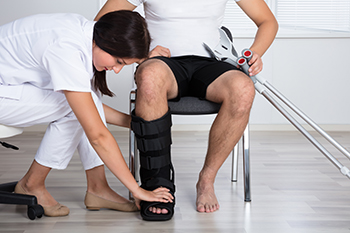
An ankle avulsion fracture occurs when a small piece of bone is pulled off by a ligament or tendon. This injury affects not only the bone but also the surrounding soft tissues, including muscles, ligaments, tendons, and nerves. Recovery typically spans four to six weeks, though some discomfort may persist beyond this period. Factors like smoking and certain medical conditions, such as diabetes, can hinder recovery. Therefore, it is important to maintain a healthy lifestyle and find out if medication that you are taking may impede healing. Pain and swelling are common after an ankle avulsion fracture, and they may vary with your activity level and time of day. Supportive footwear, such as a boot or crutches, may be prescribed to aid in recovery. It is advisable to gradually resume daily activities, keeping in mind that some pain and reduced flexibility are normal as you heal. If you are experiencing extreme ankle pain and believe you may have a fracture, it is suggested that you promptly schedule an appointment with a podiatrist.
Broken ankles need immediate treatment. If you are seeking treatment, contact Howard Waxman, DPM from Pleasant Valley Podiatry. Our doctor can provide the care you need to keep you pain-free and on your feet.
Broken Ankles
A broken ankle is experienced when a person fractures their tibia or fibula in the lower leg and ankle area. Both of these bones are attached at the bottom of the leg and combine to form what we know to be our ankle.
When a physician is referring to a break of the ankle, he or she is usually referring to a break in the area where the tibia and fibula are joined to create our ankle joint. Ankles are more prone to fractures because the ankle is an area that suffers a lot of pressure and stress. There are some obvious signs when a person experiences a fractured ankle, and the following symptoms may be present.
Symptoms of a Fractured Ankle
If you suspect an ankle fracture, it is recommended to seek treatment as soon as possible. The sooner you have your podiatrist diagnose the fracture, the quicker you’ll be on the way towards recovery.
If you have any questions, please feel free to contact one of our offices located in Willoughby Hills and Broadview Heights, OH . We offer the newest diagnostic and treatment technologies for all your foot care needs.
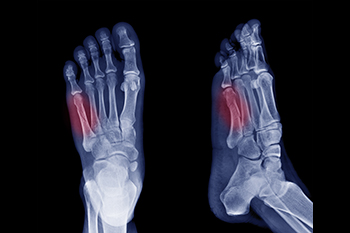
A Jones fracture is a break, or hairline crack, in the fifth metatarsal, which is the long bone on the outside of the foot near the ankle. Symptoms can include pain, swelling, tenderness on the outer side of the foot, bruising, and difficulty walking. Diagnosing a Jones fracture typically involves a podiatrist who examines the foot, discusses symptoms, and takes a medical history. In most cases an X-ray or other imaging test is performed to confirm the fracture. Treatment varies based on the severity of the fracture. Minor Jones fractures may be managed with rest, pain relief, and possibly a cast or splint. Crutches might also be needed to avoid putting weight on the foot. More severe fractures could require surgery. Recovery can take up to several months, emphasizing the need for complete healing to prevent re-injury. If you have a Jones fracture on your foot, it is suggested that you schedule an appointment with a podiatrist for an exam, diagnosis, and treatment.
A broken foot requires immediate medical attention and treatment. If you need your feet checked, contact Howard Waxman, DPM from Pleasant Valley Podiatry. Our doctor can provide the care you need to keep you pain-free and on your feet.
Broken Foot Causes, Symptoms, and Treatment
A broken foot is caused by one of the bones in the foot typically breaking when bended, crushed, or stretched beyond its natural capabilities. Usually the location of the fracture indicates how the break occurred, whether it was through an object, fall, or any other type of injury.
Common Symptoms of Broken Feet:
Those that suspect they have a broken foot shoot seek urgent medical attention where a medical professional could diagnose the severity.
Treatment for broken bones varies depending on the cause, severity and location. Some will require the use of splints, casts or crutches while others could even involve surgery to repair the broken bones. Personal care includes the use of ice and keeping the foot stabilized and elevated.
If you have any questions please feel free to contact one of our offices located in Willoughby Hills and Broadview Heights, OH . We offer the newest diagnostic and treatment technologies for all your foot and ankle needs.
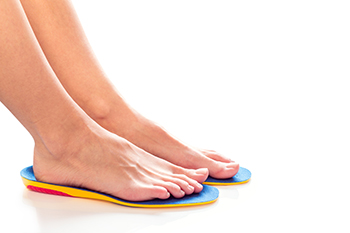 Orthotics significantly contribute to alleviating foot pain by offering customized support and rectifying biomechanical imbalances. These specially crafted insoles help redistribute pressure across the feet, minimizing strain on specific areas such as the arches, heels, and balls of the feet. This pressure relief can substantially reduce discomfort associated with conditions like plantar fasciitis, flat feet, and metatarsalgia. In addition to orthotics, other treatments can enhance the management of foot pain. Gentle exercises can strengthen the muscles and improve flexibility, aiding in pain relief and preventing future injuries. Anti-inflammatory medications and pain relievers can help manage acute discomfort. For more severe cases, corticosteroid injections may be used to reduce inflammation and pain. Combining orthotics with proper footwear, stretching routines, and weight management further optimizes treatment outcomes. If you have persistent foot pain, it is suggested that you consult a podiatrist for a comprehensive approach, tailoring a treatment plan that includes orthotics and other modalities to effectively manage and alleviate the pain.
Orthotics significantly contribute to alleviating foot pain by offering customized support and rectifying biomechanical imbalances. These specially crafted insoles help redistribute pressure across the feet, minimizing strain on specific areas such as the arches, heels, and balls of the feet. This pressure relief can substantially reduce discomfort associated with conditions like plantar fasciitis, flat feet, and metatarsalgia. In addition to orthotics, other treatments can enhance the management of foot pain. Gentle exercises can strengthen the muscles and improve flexibility, aiding in pain relief and preventing future injuries. Anti-inflammatory medications and pain relievers can help manage acute discomfort. For more severe cases, corticosteroid injections may be used to reduce inflammation and pain. Combining orthotics with proper footwear, stretching routines, and weight management further optimizes treatment outcomes. If you have persistent foot pain, it is suggested that you consult a podiatrist for a comprehensive approach, tailoring a treatment plan that includes orthotics and other modalities to effectively manage and alleviate the pain.
If you are having discomfort in your feet and would like to try orthotics, contact Howard Waxman, DPM from Pleasant Valley Podiatry. Our doctor can provide the care you need to keep you pain-free and on your feet.
What Are Orthotics?
Orthotics are inserts you can place into your shoes to help with a variety of foot problems such as flat feet or foot pain. Orthotics provide relief and comfort for minor foot and heel pain but can’t correct serious biomechanical problems in your feet.
Over-the-Counter Inserts
Orthotics come in a wide variety of over-the-counter inserts that are used to treat foot pain, heel pain, and minor problems. For example, arch supports can be inserted into your shoes to help correct overarched or flat feet, while gel insoles are often used because they provide comfort and relief from foot and heel pain by alleviating pressure.
Prescription Orthotics
If over-the-counter inserts don’t work for you or if you have a more severe foot concern, it is possible to have your podiatrist prescribe custom orthotics. These high-quality inserts are designed to treat problems such as abnormal motion, plantar fasciitis, and severe forms of heel pain. They can even be used to help patients suffering from diabetes by treating foot ulcers and painful calluses and are usually molded to your feet individually, which allows them to provide full support and comfort.
If you are experiencing minor to severe foot or heel pain, it’s recommended to speak with your podiatrist about the possibilities of using orthotics. A podiatrist can determine which type of orthotic is right for you and allow you to take the first steps towards being pain-free.
If you have any questions please contact one of our offices located in Willoughby Hills and Broadview Heights, OH . We offer the newest diagnostic and treatment technologies for all your foot and ankle needs.
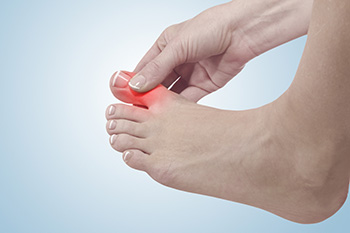
Hallux limitus is a condition where movement in the big toe joint is restricted, often due to arthritis or structural abnormalities. Symptoms include pain, stiffness, swelling, and difficulty bending the toe when walking or pushing off during activities. Preventing hallux limitus involves wearing supportive footwear with a wide toe box to reduce pressure on the joint. Toe exercises and maintaining a healthy weight can also help. Treatment options vary depending on the severity and may include shoe modifications, orthotic inserts, physical therapy, or anti-inflammatory medications. In advanced cases, surgical interventions like joint fusion or joint replacement may be necessary to restore function. If you experience persistent pain or notice changes in your toe joint mobility, consulting a podiatrist is suggested. This foot doctor can diagnose the condition accurately, assess its impact on your foot health, and recommend the most effective treatment plan to alleviate symptoms and improve mobility.
Foot Pain
Foot pain can be extremely painful and debilitating. If you have a foot pain, consult with Howard Waxman, DPM from Pleasant Valley Podiatry. Our doctor will assess your condition and provide you with quality foot and ankle treatment.
Causes
Foot pain is a very broad condition that could be caused by one or more ailments. The most common include:
Diagnosis
To figure out the cause of foot pain, podiatrists utilize several different methods. This can range from simple visual inspections and sensation tests to X-rays and MRI scans. Prior medical history, family medical history, and any recent physical traumatic events will all be taken into consideration for a proper diagnosis.
Treatment
Treatment depends upon the cause of the foot pain. Whether it is resting, staying off the foot, or having surgery; podiatrists have a number of treatment options available for foot pain.
If you have any questions, please feel free to contact one of our offices located in Willoughby Hills and Broadview Heights, OH . We offer the newest diagnostic and treatment technologies for all your foot care needs.
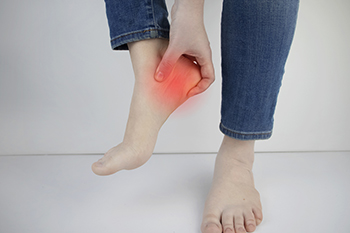
Plantar fasciitis is a common condition characterized by inflammation of the plantar fascia, a thick band of tissue that runs along the bottom of the foot. Symptoms often include sharp heel pain, especially in the morning or after long periods of rest. Causes of plantar fasciitis can vary, with overpronation, where the foot rolls inward excessively, being a significant factor. Additionally, differences in leg length can contribute to uneven stress on the feet. Relief options are available, including stretching exercises, orthotic supports, and proper footwear. Using anti-inflammatory medications can also help alleviate pain. If you have heel pain, it is strongly suggested that you consult a podiatrist who can successfully treat plantar fasciitis.
Plantar fasciitis is a common foot condition that is often caused by a strain injury. If you are experiencing heel pain or symptoms of plantar fasciitis, contact Howard Waxman, DPM from Pleasant Valley Podiatry. Our doctor can provide the care you need to keep you pain-free and on your feet.
What Is Plantar Fasciitis?
Plantar fasciitis is one of the most common causes of heel pain. The plantar fascia is a ligament that connects your heel to the front of your foot. When this ligament becomes inflamed, plantar fasciitis is the result. If you have plantar fasciitis you will have a stabbing pain that usually occurs with your first steps in the morning. As the day progresses and you walk around more, this pain will start to disappear, but it will return after long periods of standing or sitting.
What Causes Plantar Fasciitis?
There are some risk factors that may make you more likely to develop plantar fasciitis compared to others. The condition most commonly affects adults between the ages of 40 and 60. It also tends to affect people who are obese because the extra pounds result in extra stress being placed on the plantar fascia.
Prevention
There are a variety of treatment options available for plantar fasciitis along with the pain that accompanies it. Additionally, physical therapy is a very important component in the treatment process. It is important that you meet with your podiatrist to determine which treatment option is best for you.
If you have any questions, please feel free to contact one of our offices located in Willoughby Hills and Broadview Heights, OH . We offer the newest diagnostic and treatment technologies for all your foot care needs.

Dragging your feet might seem like a minor inconvenience, but it can actually be a sign of a serious condition known as drop foot. Drop foot occurs when you have difficulty lifting the front part of your foot, causing it to drag while you walk. This problem can arise from various health issues affecting the muscles, nerves, or structure of the leg or foot. Common causes can include peroneal nerve injury, which affects movement and sensation in the lower leg, foot, and toes. Other conditions leading to drop foot include peripheral neuropathy from diabetes, muscular dystrophy, stroke, and multiple sclerosis. Symptoms of drop foot include difficulty in walking, a stepping gait where the foot slaps the ground, and potential numbness or tingling in the foot. Diagnosis by a podiatrist involves a physical exam and tests such as electromyography, or EMG, nerve conduction studies, and imaging scans. Treatment depends on the cause and can include orthotic devices, nerve stimulation, or surgery. If you are experiencing trouble walking normally, it is suggested that you schedule an appointment with a podiatrist for an exam and treatment.
If you have any concerns about your feet, contact Howard Waxman, DPM from Pleasant Valley Podiatry. Our doctor can provide the care you need to keep you pain-free and on your feet.
Biomechanics in Podiatry
Podiatric biomechanics is a particular sector of specialty podiatry with licensed practitioners who are trained to diagnose and treat conditions affecting the foot, ankle and lower leg. Biomechanics deals with the forces that act against the body, causing an interference with the biological structures. It focuses on the movement of the ankle, the foot and the forces that interact with them.
A History of Biomechanics
Modern technological improvements are based on past theories and therapeutic processes that provide a better understanding of podiatric concepts for biomechanics. Computers can provide accurate information about the forces and patterns of the feet and lower legs.
Understanding biomechanics of the feet can help improve and eliminate pain, stopping further stress to the foot.
If you have any questions please feel free to contact one of our offices located in Willoughby Hills and Broadview Heights, OH . We offer the newest diagnostic and treatment technologies for all your foot and ankle needs.
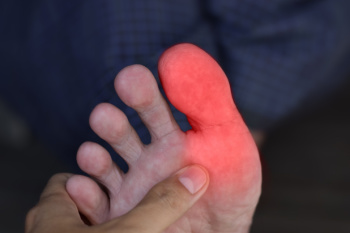 Toe pain can arise from various conditions, each requiring careful attention. Bunions, a common cause, involve a bony bump forming at the base of the big toe, leading to discomfort and swelling. Arthritis, particularly osteoarthritis and rheumatoid arthritis, can cause joint inflammation and stiffness, affecting toe movement. Infections, whether fungal or bacterial, may result in redness, swelling, and severe pain. Injuries such as fractures or sprains often lead to immediate and intense pain, impairing mobility. Peripheral artery disease, or PAD, restricts blood flow to the extremities, causing pain, especially during walking. If you have toe pain, it is suggested that you visit a podiatrist who can determine the cause and offer appropriate treatment solutions.
Toe pain can arise from various conditions, each requiring careful attention. Bunions, a common cause, involve a bony bump forming at the base of the big toe, leading to discomfort and swelling. Arthritis, particularly osteoarthritis and rheumatoid arthritis, can cause joint inflammation and stiffness, affecting toe movement. Infections, whether fungal or bacterial, may result in redness, swelling, and severe pain. Injuries such as fractures or sprains often lead to immediate and intense pain, impairing mobility. Peripheral artery disease, or PAD, restricts blood flow to the extremities, causing pain, especially during walking. If you have toe pain, it is suggested that you visit a podiatrist who can determine the cause and offer appropriate treatment solutions.
Toe pain can disrupt your daily activities. If you have any concerns, contact Howard Waxman, DPM of Pleasant Valley Podiatry. Our doctor can provide the care you need to keep you pain-free and on your feet.
What Causes Toe Pain?
Most severe toe pain is caused due to a sports injury, trauma from dropping something heavy on the toe, or bumping into something rigid. Other problems can develop over time for various reasons.
Toe pain can be caused by one or more ailments. The most common include:
When to See a Podiatrist
Diagnosis
In many cases the cause of toe pain is obvious, but in others, a podiatrist may want to use more advanced methods to determine the problem. These can range from simple visual inspections and sensation tests to X-rays and MRI scans. Prior medical history, family medical history, and any recent physical traumatic events will all be taken into consideration for a proper diagnosis.
Treatment
Treatments for toe pain and injuries vary and may include shoe inserts, padding, taping, medicines, injections, and in some cases, surgery. If you believe that you have broken a toe, please see a podiatrist as soon as possible.
If you have any questions please feel free to contact one of our offices located in Willoughby Hills and Broadview Heights, OH . We offer the newest diagnostic tools and technology to treat your foot and ankle needs.